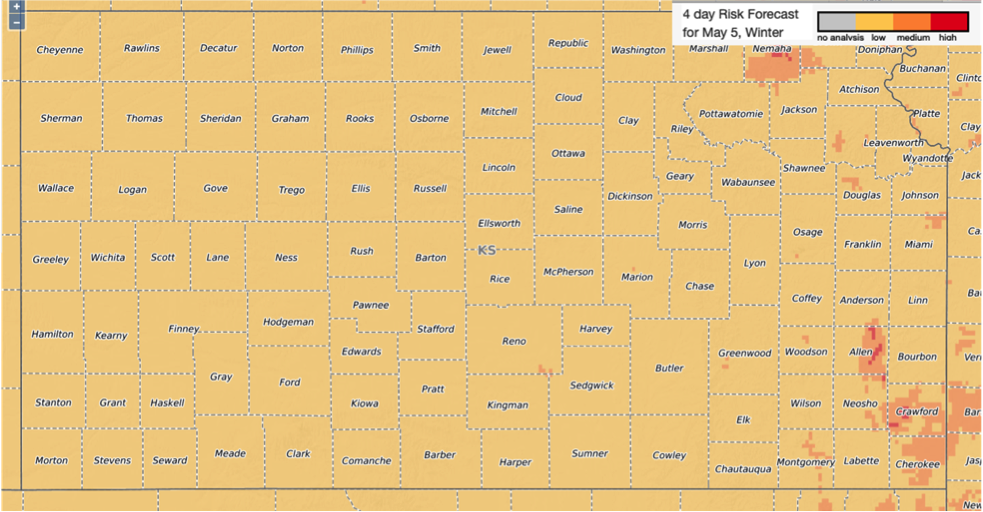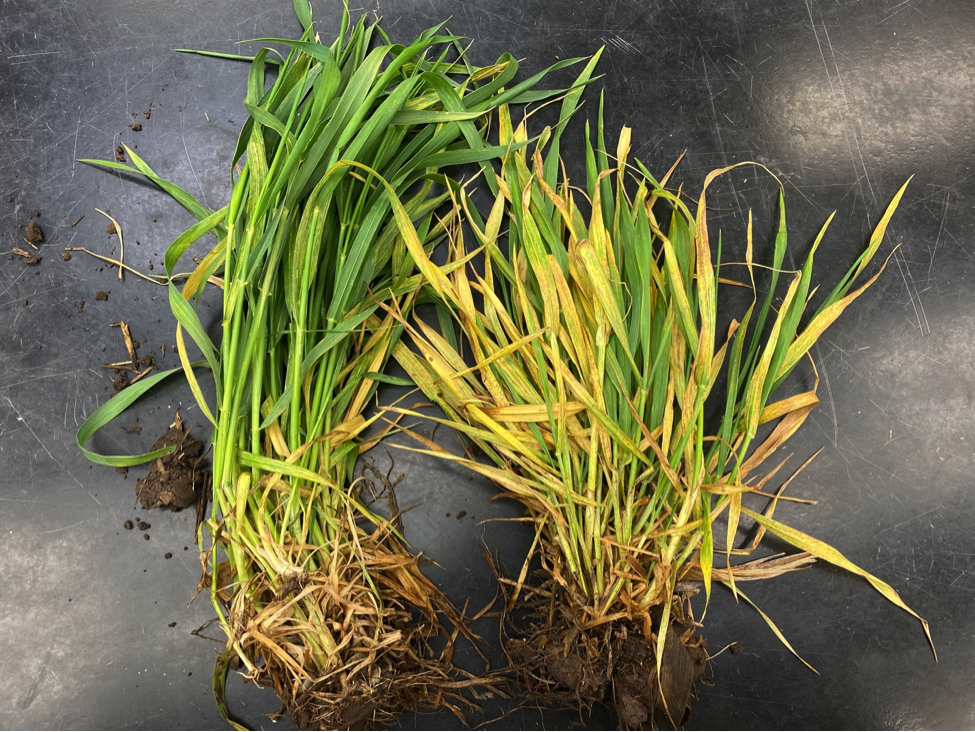As wheat moves into the flowering stage of growth in southeast Kansas and into heading and boot stages of growth in central Kansas, there are a few diseases that are on the mind of many producers and advisors, including:
- Rusts (stripe and leaf)
- Fusarium head blight (scab)
- Wheat streak mosaic virus (and related viruses)
In this article we will discuss the current outlook for these diseases, and the potential need for management.
Stripe rust and leaf rust
At the time of publication, we have not detected stripe rust (Figure 1) or leaf rust in Kansas. This indicates that dry conditions have substantially limited the spread of these pathogens in this region. Forecasted warm, dry weather ahead suggests that there is low likelihood of a yield-limiting rust outbreak in 2022. Exceptions include pockets of the state, such as the southeast, that are experiencing higher rainfall levels.
With this warm, dry weather in mind many are weighing the need for wheat foliar fungicides this season. We suggest prioritizing fields with yield potential greater than 40 bu/acre, fields that are under irrigation, or fields that are being used for seed production. Fields that have experienced substantial yield reductions due to drought will likely not benefit from an application at this point.
For more information about specific fungicide product efficacy, please see the K-State foliar fungicide efficacy ratings: https://bookstore.ksre.ksu.edu/pubs/ep130.pdf.

Figure 1. Classic symptoms of stripe rust. No stripe rust has been reported in Kansas as of May 5, 2022. Photo by K-State Research and Extension.
Fusarium head blight (aka Scab)
As a reminder, the wheat crop is only susceptible to Fusarium head blight during flowering (when yellow anthers are present). Early flowering (Feekes 10.5.1) is the optimal timing for a scab fungicide application. As the southeast part of the state comes into the flowering period of growth, it will be important to carefully monitor crop growth states for a scab fungicide application. We are currently seeing slightly elevated weather risk in Cherokee, Crawford and Allen counties (Figure 2). We will continue to report risk as the rest of the state moves toward the flowering growth stage.

Figure 2. Fusarium head blight (Scab) risk forecast for the next 4 days after May 5 according to wheatscab.psu.edu. This model is calibrated for very susceptible varieties, which should be prioritized for a fungicide application. Yellow indicates low risk, while red indicates elevated risk.
Fungicides such as Prosaro, Caramba, Proline, or Miravis Ace are known to suppress scab. Other fungicides are not labeled or not recommended for scab control. These fungicides are most effective against scab when applied at early flowering (Feekes 10.5.1), but can provide protection even when applied later in the flowering window. It is important to pay attention to pre-harvest intervals at this point of the season and follow guidelines provided on product labels. The products listed above have either a 30-day pre-harvest interval (cannot be applied within 30 days of harvest) or cannot be applied after Feekes 10.5.4 (end of flowering, watery ripe growth stage).
It is important to remember that early flag-leaf fungicide applications will have little to no effect on scab.
Wheat streak mosaic virus
Warming weather has led to the expression of wheat streak mosaic virus (Figure 3) symptoms in several parts of Kansas. Even for the highly trained eye, it can be difficult to differentiate symptoms of wheat viruses. Wheat streak mosaic virus symptoms can be easily confused with other viruses. Multiple viruses can also be present in the same plant. Samples can be submitted to the K-State Plant Diagnostic Clinic for verification of viral diseases. Contact your local K-State Extension Office for more information.

Figure 3. Plants with classic symptoms of wheat streak mosaic virus that were submitted to the K-State plant diagnostic clinic this week. Photo by K-State Reseearch and Extension.
You can find more information about the K-State plant diagnostic lab here: https://www.plantpath.k-state.edu/extension/diagnostic-lab/
Contact information for K-State Plant Disease Diagnostic Lab: clinic@ksu.edu
Kelsey Andersen Onofre, Wheat and Forage Pathology Specialist
Tags: wheat disease wheat rust